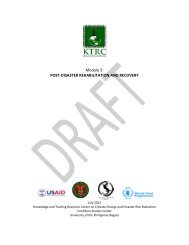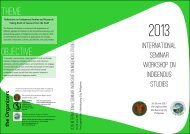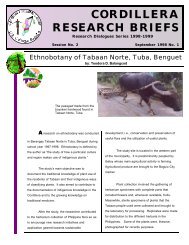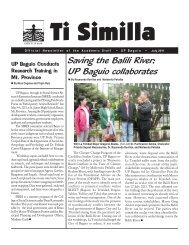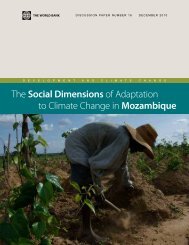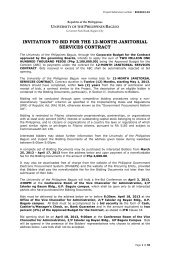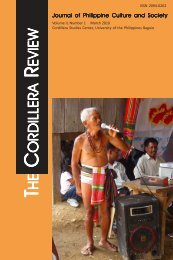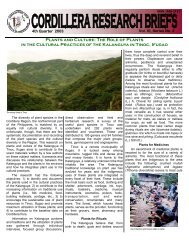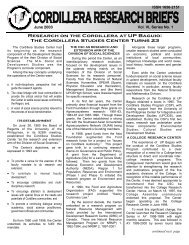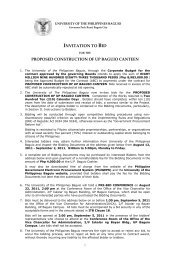Pambansang Summit sa W ambansang Summit sa W ... - UP Baguio
Pambansang Summit sa W ambansang Summit sa W ... - UP Baguio
Pambansang Summit sa W ambansang Summit sa W ... - UP Baguio
Create successful ePaper yourself
Turn your PDF publications into a flip-book with our unique Google optimized e-Paper software.
a smaller close relative – the Moina - is<br />
found locally. As per record, Daphnia is<br />
the first crustacean to have its genome<br />
sequenced and is the animal with the most<br />
genes numbering to 31,000 compared to<br />
humans having only 23,000. Daphnia’s<br />
high gene number is largely due to its<br />
genes multiplying at a higher rate than<br />
other species. This occurs at about a threefold<br />
rate higher than other invertebrates,<br />
30% greater than humans. Dr. Medina<br />
mentioned that more than one-third of<br />
Daphnia’s genes are undocumented in any<br />
other organism. In other words, they are<br />
completely new to science. Of all<br />
sequenced invertebrate genomes so far,<br />
Daphnia shares the most genes with<br />
humans. Due to Daphnia’s genetic wealth,<br />
it is emerging as a model organism for a<br />
new field of science - Environmental<br />
Genomics. This field endeavors to<br />
understand how the environment and<br />
genes interact. Since the majority of<br />
duplicated and unknown genes are<br />
sensitive to environmental conditions,<br />
their accumulation in the genome could<br />
account for Daphnia’s flexible responses<br />
to environmental change.<br />
Mus musculus (laboratory mouse) is<br />
another perpetual model organism used<br />
in research. Its genetic and physiological<br />
similarities to humans allows for the<br />
generation of disease and treatment<br />
Daphnia is central to a new field, environmental genomics<br />
models. Its<br />
entire genome<br />
sequenced<br />
allows for the<br />
generation of<br />
specific<br />
m u t a n t<br />
lineages and<br />
reverse<br />
genetics<br />
studies.<br />
Genetically,<br />
the lab mouse<br />
has 40 chromosomes<br />
with three<br />
billion bases.<br />
It is the<br />
Lecture<br />
Drosophila (fruit fly)<br />
organism that is the most genetically<br />
identical to humans among model<br />
organisms. Currently, there are 426 major<br />
inbred strains available and a significant<br />
gene functional studies involves gene<br />
knockouts. A knockout mouse is a<br />
genetically engineered mouse in which one<br />
or more genes have been turned off<br />
through a targeted mutation. By causing<br />
a specific gene to be inactive in the mouse,<br />
and observing any differences from<br />
normal behavior or condition, researchers<br />
can infer its probable function. Currently<br />
used mouse models for human disease are<br />
for Alzheimer’s disease, Down syndrome,<br />
cystic fibrosis, cancer, glaucoma,<br />
types 1 and 2 diabetes, epilepsy,<br />
heart disease, muscular dystrophy,<br />
and many more. Unfortunately,<br />
use of lab mice draws negative<br />
attention from animal rights<br />
activists (i.e. PETA) and is<br />
considered immoral in some social<br />
circles.<br />
Drosophila (fruit fly) is<br />
considered an awesome research<br />
tool that can be used to investigate<br />
biological and biomedical<br />
questions. This is due to its small<br />
size (~ 4mm), very fecund (~ 50<br />
eggs/day/female), with short<br />
generation time (14 days), a large<br />
number of visible markers, a small<br />
number of chromosomes (4),<br />
amenable to various molecular<br />
manipulations, and 75% of human<br />
disease genes have counterparts in<br />
Drosophila. Diverse research areas using<br />
flies include studies on developmental<br />
processes, genetic mechanisms,<br />
neurodegenerative disease, aging,<br />
metabolic disorders, alcoholism and other<br />
addictions, cancer, heart disease, and<br />
others.<br />
During the practical sessions which<br />
followed immediately after the lecture, the<br />
junior faculty members of the department<br />
assisted Dr. Medina in giving<br />
demonstrations on handling the model<br />
organisms mentioned above. Freda Wong<br />
demonstrated the proper techniques<br />
employed in performing intraperitoneal<br />
injection, retroorbital bleeding, and<br />
dissection of mice. Noreen Follosco, on<br />
the other hand, demonstrated techniques<br />
in the preparation and maintenance of<br />
Drosophila cultures. Moreover, she<br />
demonstrated a technique in isolating<br />
polytene chromosomes. Jaime Cañedo<br />
also demonstrated the morphology and<br />
biology of Daphnia as well as the<br />
maintenance of Daphnia culture. Dr.<br />
Medina himself showed actual cultures of<br />
C. elegans and discussed how to maintain<br />
the stock culture. He also took the chance<br />
to teach the participants simple lab<br />
techniques such as determining a gram<br />
negative or gram positive bacteria using<br />
sodium hydroxide solution instead of<br />
employing the conventional gram staining<br />
method.<br />
April 2011 TI SIMILLA 9





